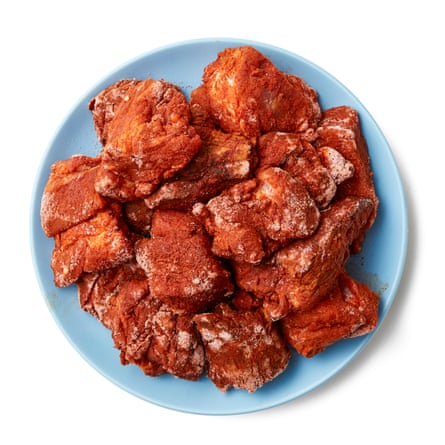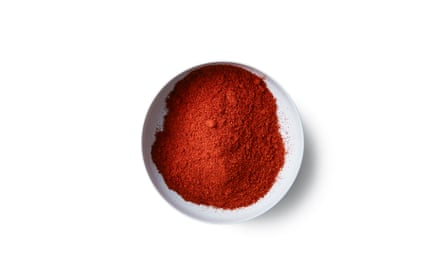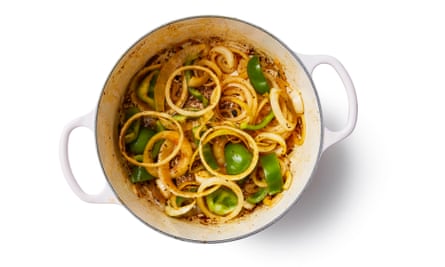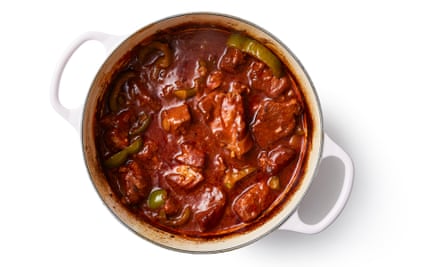How to make pork goulash – recipe - The Guardian
If you order a gulyás in Hungary, you’ll get a hearty bowl of soup, so if you’re after the richly flavoured, brick-red stew known elsewhere as a goulash, go for a pörkölt instead. Linguistic confusion aside, in truth, the two dishes share much the same flavour profile – onions, peppers, paprika and meat – and are equally good at warming up a winter’s evening, whether you’re in Budapest or Belfast.
Prep 15 min
Cook 3 hr
Serves 4
1kg pork shoulder (see step 1)
4 tbsp sweet Hungarian paprika (see step 2)
2 tbsp flour, or cornflour
1 tsp salt
2 onions
1 large green pepper (see step 3)
2 tbsp lard, or dripping, goose or duck fat, or oil
1 tsp caraway seeds (optional)
1 tbsp tomato puree
Juice of 1 lemon
150ml soured cream (optional)
1 small bunch chives (optional)
1 Choose your meat

Though most often seen with beef (I like shin), this stew can be made with venison, lamb, carp, offal or chicken thighs. Here, I’ve used pork shoulder, but you can substitute any of the above, but steer clear of anything that’s too lean and adjust the cooking time accordingly. (Note that if the meat does not have a generous coating of fat, you’ll need less of it: 600-800g.) Cut the meat into large chunks.
2 A note on the paprika

Though you can make this dish with ordinary supermarket paprika (not the hot or smoked sort), from disappointing experience I’d advise getting the fruitier, redder Hungarian stuff that can be found in eastern European shops and online. Mix the paprika, flour and salt in a wide bowl, then toss the meat in this to coat.
3 Prepare the veg

Heat the oven to 160C (140C fan)/325F/gas 3. Peel and thickly slice the onions, and cut the pepper into chunky rounds, removing the pith and seeds as you go. Though green pepper is a key element (and if you can find the pointed pale green peppers favoured in Hungary, all the better), if you’re not a fan, you can swap in the red sort.
4 Melt the fat
Melt the lard (though, given the puzzling difficulty of finding good-quality stuff in Britain, you could also use another animal fat or oil instead) in a heavy-based casserole on a medium-high heat. If you don’t have a suitable lidded pot that can go on the hob, too, use a frying pan for this step, then transfer the contents to an oven dish later.
5 Brown the meat and soften the veg

Brown the meat in batches, setting any excess spiced flour aside for now and being careful not to overcrowd the pan, until golden and crusted on all sides, then transfer to a bowl and repeat with the remaining pork. Turn down the heat, add a little more fat and the onions to the pot, then cook, stirring, until slightly softened. Add the pepper and caraway, if using, then fry, stirring regularly, until soft and beginning to colour.

6 Cook out the remaining flour mix

Remove the peppers and set aside. Stir the leftover flour and spice mixture and the tomato puree into the onions, and cook for a couple of minutes, stirring to scrape off any flour and meaty bits stuck to the bottom of the pan. Stir in about 400ml water, then return the meat to the pan along with any of its resting juices.
7 Transfer to the oven and braise
Bring the water to a simmer. (If you’ve been using a frying pan and are transferring it to an ovenproof casserole dish, do so at this point.) Cover and put in the oven for about two hours, or until the meat is very tender – begin checking at 90 minutes, and move on to the next step once it’s ready.
8 Finishing touches

Stir in the lemon juice and green pepper, then return to the oven for another 20-30 minutes, uncovered unless the gravy is already well reduced. Check the seasoning, and adjust if necessary. If your meat is very fatty, you may want to pass the sauce through a gravy separator or, if making ahead, chill and lift off the solid fat before reheating.
9 Serving suggestions

Serve the stew with soured cream and chopped chives on the side, for people to help themselves. Porkölt is good with lightly crushed buttered boiled potatoes, or dumplings, or buttered egg noodles (spätzle are easy to make, but pasta or the noodles found in eastern European specialists will work well, too). It also reheats and freezes well.
from "food recipes" - Google News https://ift.tt/pLN2cHG
via IFTTT
Comments
Post a Comment